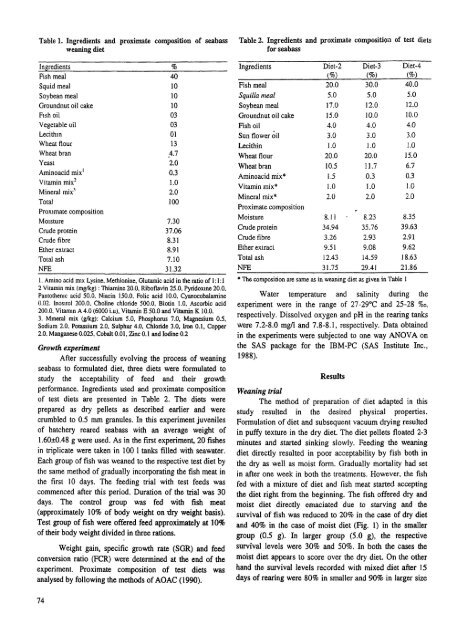Preliminary Studies on the Formulation and Presentation of ...
Preliminary Studies on the Formulation and Presentation of ...
Preliminary Studies on the Formulation and Presentation of ...
Create successful ePaper yourself
Turn your PDF publications into a flip-book with our unique Google optimized e-Paper software.
Table 1. Ingredients <strong>and</strong> proximate compositi<strong>on</strong> <strong>of</strong> seabass<br />
weaning diet<br />
Ingredients %<br />
Fish meal 40<br />
Squid meal 10<br />
Soybean meal 10<br />
Groundnut oil cake<br />
F~sh oil<br />
Vegetable oil<br />
Lecith~n<br />
Wheat flour<br />
Wheat bran<br />
Yeast<br />
Aminoacid mix'<br />
Vitamin mix'<br />
Mineral mix'<br />
Total<br />
Prox~mate compositi<strong>on</strong><br />
Mo~sture 7.30<br />
Crude protein 37.06<br />
Crude tibre 8.31<br />
E<strong>the</strong>r extract 8.91<br />
Total ash 7.10<br />
NFE 31.32<br />
1. Amino acid mlx Lysine. Methi<strong>on</strong>ine, Glutamic acid in <strong>the</strong> ratio <strong>of</strong> 1: I:l<br />
2 Vitamin mix (mgtkg) : Thiamine 20.0, Rib<strong>of</strong>lavin 25.0, Pyridox~ne 20.0,<br />
Panto<strong>the</strong>n~c acid 50.0. Niacin 150.0. Folic acid 10.0. Cyanocobalamine<br />
0.02. lnosltol 2C0.0. Choline chloride 500.0, Biotin 1.0. Ascorbic acid<br />
2(M).O. Vitamin A4.0 (6000 i.u), Vitamin E 50.0 <strong>and</strong> Vitamin K 10.0.<br />
3. M~nenl mix (glkg): Calcium 5.0. Phosphorus 7.0. Magnesium 0.5,<br />
Sodium 2.0. Potassium 2.0. Sulphur 4.0. Chloride 3.0, Ir<strong>on</strong> 0.1, Copper<br />
2.0. Manganese 0.025, Cobalt 0.01, Zinc 0.1 <strong>and</strong> Iodine 0.2<br />
Growth experiment<br />
After successfully evolving <strong>the</strong> process <strong>of</strong> weaning<br />
seabass to formulated diet, three diets were formulated to<br />
study <strong>the</strong> acceptability <strong>of</strong> feed <strong>and</strong> <strong>the</strong>ir growth<br />
performance. Ingredients used <strong>and</strong> proximate compositi<strong>on</strong><br />
<strong>of</strong> test diets are presented in Table 2. The diets were<br />
prepared as dry pellets as described earlier <strong>and</strong> were<br />
crumbled to 0.5 mm granules. In this experiment juveniles<br />
<strong>of</strong> hatchery reared seabass with an average weight <strong>of</strong><br />
1.60+0.48 g were used. As in <strong>the</strong> first experiment, 20 fishes<br />
in triplicate were taken in 100 1 tanks filled with seawater.<br />
Each group <strong>of</strong> fish was weaned to <strong>the</strong> respective test diet by<br />
<strong>the</strong> same method <strong>of</strong> gradually incorporating <strong>the</strong> fish meat in<br />
<strong>the</strong> first 10 days. The feeding trial with test feeds was<br />
commenced after this period. Durati<strong>on</strong> <strong>of</strong> <strong>the</strong> trial was 30<br />
days. The c<strong>on</strong>trol group was fed with fish meat<br />
(approximately 10% <strong>of</strong> body weight <strong>on</strong> dry weight basis).<br />
Test group <strong>of</strong> fish were <strong>of</strong>fered feed approximately at 10%<br />
<strong>of</strong> <strong>the</strong>ir body weight divided in three rati<strong>on</strong>s.<br />
Weight gain, specific growth rate (SGR) <strong>and</strong> feed<br />
c<strong>on</strong>versi<strong>on</strong> ratio (FCR) were determined at <strong>the</strong> end <strong>of</strong> <strong>the</strong><br />
experiment. Proximate compositi<strong>on</strong> <strong>of</strong> test diets was<br />
analysed by following <strong>the</strong> methods <strong>of</strong> AOAC (1990).<br />
Table2. Ingredients <strong>and</strong> proximate compositi<strong>on</strong> <strong>of</strong> test diets<br />
for seabass<br />
Ingredients Diet-2 Diet-3 Diet-4<br />
(%) (%) (%I<br />
Fish meal 20.0 30.0 40.0<br />
Squilla nzeal 5.0 5.0 5.0<br />
Soybean meal 17.0 12.0 12.0<br />
Groundnut oil cake 15.0 10.0 10.0<br />
Fish oil 4.0 4.0 4.0<br />
Sun flower oil 3.0 3.0 3.0<br />
Lecithin 1 .O 1 .O 1 .O<br />
Wheat flour 20.0 20.0 15.0<br />
Wheat bran 10.5 11.7 6.7<br />
Aminoacid mix* 1.5 0.3 0.3<br />
Vitamin mix* I .O 1 .O I .O<br />
Mineral mix* 2.0 2.0 2.0<br />
Proximate compositi<strong>on</strong><br />
Moisture 8.11 . 8.23 8.35<br />
Crude protein 34.94 35.76 39.63<br />
Crude fibre 3.26 2.93 2.91<br />
E<strong>the</strong>r extracl 9.5 1 9.08 9.62<br />
Total ash 12.43 14.59 18.63<br />
NFE 31.75 29.41 21.86<br />
* The compositi<strong>on</strong> are same as in weaning diet as given in Table I<br />
Water temperature <strong>and</strong> salinity during <strong>the</strong><br />
experiment were in <strong>the</strong> range <strong>of</strong> 27-29°C <strong>and</strong> 25-28 %o,<br />
respectively. Dissolved oxygen <strong>and</strong> pH in <strong>the</strong> rearing tanks<br />
were 7.2-8.0 mgA <strong>and</strong> 7.8-8.1, respectively. Data obtained<br />
in <strong>the</strong> experiments were subjected to <strong>on</strong>e way ANOVA <strong>on</strong><br />
<strong>the</strong> SAS package for <strong>the</strong> IBM-PC (SAS Institute Inc.,<br />
1988).<br />
Results<br />
Weaning trial<br />
The method <strong>of</strong> preparati<strong>on</strong> <strong>of</strong> diet adapted in this<br />
study resulted in <strong>the</strong> desired physical properties.<br />
Formulati<strong>on</strong> <strong>of</strong> diet <strong>and</strong> subsequent vacuum drying resulted<br />
in puffy texture in <strong>the</strong> dry diet. The diet pellets floated 2-3<br />
minutes <strong>and</strong> started sinking slowly. Feeding <strong>the</strong> weaning<br />
diet directly resulted in poor acceptability by fish both in<br />
<strong>the</strong> dry as well as moist form. Gradually mortality had set<br />
in after <strong>on</strong>e week in both <strong>the</strong> treatments. However, <strong>the</strong> fish<br />
fed with a mixture <strong>of</strong> diet <strong>and</strong> lish meat started accepting<br />
<strong>the</strong> diet right from <strong>the</strong> beginning. The fish <strong>of</strong>fered dry <strong>and</strong><br />
moist diet directly emaciated due to starving <strong>and</strong> <strong>the</strong><br />
survival <strong>of</strong> fish was reduced to 20% in <strong>the</strong> case <strong>of</strong> dry diet<br />
<strong>and</strong> 40% in <strong>the</strong> case <strong>of</strong> moist diet (Fig. 1) in <strong>the</strong> smaller<br />
group (0.5 g). In larger group (5.0 g), <strong>the</strong> respective<br />
survival levels were 30% <strong>and</strong> 50%. In both <strong>the</strong> cases <strong>the</strong><br />
moist diet appears to score over <strong>the</strong> dry diet. On <strong>the</strong> o<strong>the</strong>r<br />
h<strong>and</strong> <strong>the</strong> survival levels recorded with mixed diet after 15<br />
days <strong>of</strong> rearing were 80% in smaller <strong>and</strong> 90% in larger size

















